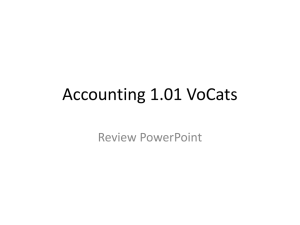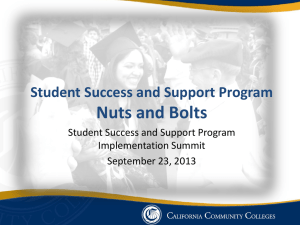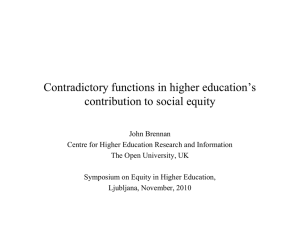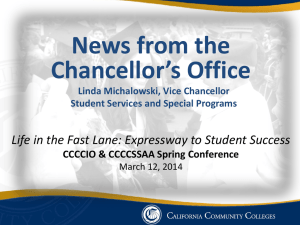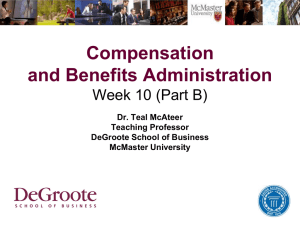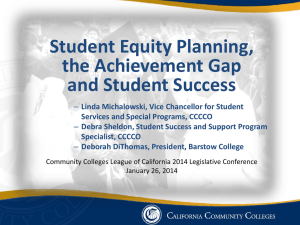Fall 2012 - California Community Colleges Chancellor`s Office
advertisement
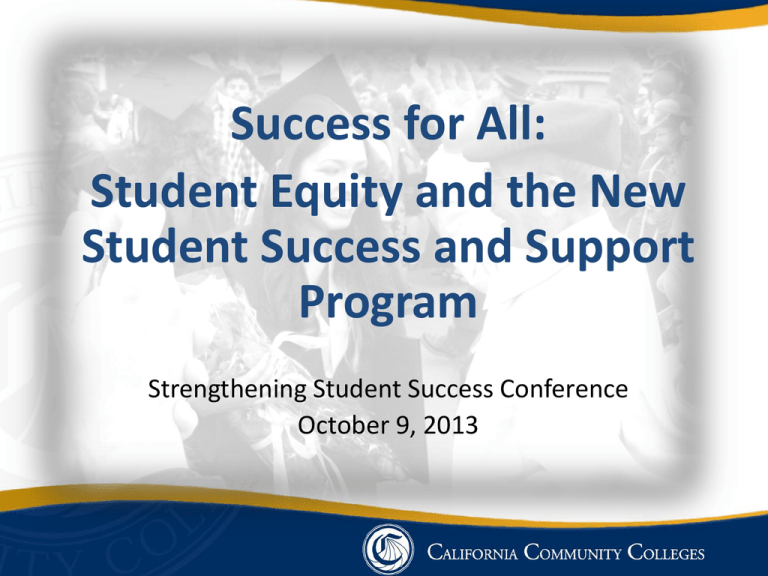
Success for All: Student Equity and the New Student Success and Support Program Strengthening Student Success Conference October 9, 2013 Student Equity Plan Update • Background • • • • Origins and purpose of CCC student equity planning Recommendations Requirements Resources Student Equity Background 2002 — BOG adopted recommendations of Task Force on Equity and Diversity for title 5 regulations requiring colleges to develop Student Equity Plan 2003 — Chancellor's Office provided guidelines to colleges for development of the plan 2005 — Chancellor's Office asked colleges to update/complete Student Equity plan Student Equity Background 2008-09 to 2012-13 economic downturn resulted in: • State budget cuts • Suspension of many regulatory requirements • Categorical program flexibility 2011— Student Success Task Force established 2012— Student Success Act of 2012 (SB1456) and reaffirmation of student equity 2013—Student Equity Workgroup convened Workgroup Recommendations • • Integrate Student Equity planning into college and district wide planning efforts: Accreditation Educational master planning Program review Student Success & Support Prog. Plan Basic skills Plan Adopt a holistic approach to planning, budgeting, and delivery of services to support equity in student access and success Planning Timelines College Education Master Plan Tied to Accreditation cycle, each three-six years, may be updated annually Student Success and Support Program Plan Every 3 years, updated annually Student Equity Planning Every 3-5 years Basic Skills Initiative Plan Every year, submitted each October (plan template/instructions released in April) Score Card* Education Master Plan/Program Review Student Equity Basic Skills Initiative Student Success & Support Program *As a starting point for discussion of institutional outcomes & equity Workgroup Recommendations ● Short Term ● ● ● Update the plan and template Align with SSSP Plan Medium to Longer Term ● ● Align with institution-wide planning Update Title V SB 1456 & Student Equity EC 78216(b)(4): Links funding to the new Scorecard EC 78216(c)(7): Delineates plan requirements & link to student equity: “Coordination with college student equity plans to ensure that the college has identified strategies to monitor and address equity issues and mitigate any disproportionate impacts on student access and achievement.” SB 1456 & Student Equity EC 78216(c)(2): Delineates plan requirements regarding college efforts to implement interventions for at-risk students: “A description of the college’s process to identify students at risk for academic or progress probation and the college’s plan for interventions or services to students.” EC 76300: BOG Fee Waiver Conditions “It is the intent of the Legislature that minimum academic and progress standards …be implemented only as campuses develop and implement the student support services and interventions necessary to ensure no disproportionate impact to students based on ethnicity, gender, disability, or socioeconomic status.” “It is the intent of the Legislature to ensure that a student shall not lose fee waiver eligibility without a community college campus first demonstrating a reasonable effort to provide a student with adequate notification and assistance in maintaining his or her fee waiver eligibility.” Student Equity Requirements • Coordinate development of SSS Program Plan (SB 1456) with the Student Equity Plan • Establish a Student Equity Planning Committee • Identify strategies to address/monitor equity • Mitigate disproportionate impact on students • Coordinate interventions and services for students at risk of academic progress or probation (Title 5, Section 55100) Student Equity Requirements • Student Equity Plan Timeline: Planning timeframe of 3-5 years Annual update Initial Plan Due October 17, 2014 Student Equity Requirements Success Indicators Access: Percentage of each pop. group enrolled compared group’s representation in adult population within community served – Census data; locally available data Course Completion: Ratio of number of credit courses that students by pop. group complete compared to number of courses in which students in that group are enrolled on the census day of term - DataMart ESL and Basic Skills Completion: Ratio of number of students by pop. group who complete a degree-applicable course after having completed the final ESL or basic skills course to the number of those students who complete such a final course - DataMart; Scorecard; Basic Skills Tracker Student Equity Requirements Success Indicators (continued) Degree and Certificate Completion: Ratio of number of students by pop. group who receive a degree or certificate to number of students in that group with same informed education goal as documented in student ed. plan – DataMart; Scorecard Transfer: Ratio of number of students by pop. group who complete a min. of 12 units and have attempted a transfer level course in math or English, to number in that group who transfer after one or more (up to six) years – DataMart; Scorecard Student Success and Support Services: The effect of mandatory participation of new students in SSSP services and enrollment priority on indicators A-E above, as well as the loss of Board of Governors (BOG) fee waiver of new students. Student Equity Planning Resources Guidelines for Measuring Disproportionate Impact (DI) in Equity Plans Simple Definition of DI: “A condition in which some students’ access to key courses, resources, and supports and ultimately their academic success may be hampered by inequitable practices, policies and approaches.” To assess equity, analyses should use one or more of the following disaggregated subgroups: • Gender • Ethnicity • Age • Disability Status • Economically Disadvantaged Student Equity Planning Resources Guidelines for Measuring Disproportionate Impact in Equity Plans Two methodologies: Proportionality: Compares the percentage of a disaggregated subgroup in an initial cohort to its own percentage in the resultant outcome group 80-Percent Rule: Compares the percentage of each disaggregated subgroup attaining an outcome to the percentage attained by a reference subgroup Student Equity Planning Resources A Guide to Assessing & Mitigating Disproportionate Impact in Student Success and Support Programs – Developed by the Research and Planning Group for CCC (RP Group) The guide has been developed to: Help colleges better understand concept of DI as it relates to SSSP components and the need to examine relevant data related to these services Provide colleges with the tools that will help them conduct DI impact students Present strategies that have the potential to mitigate DI Guide’s Focus Examines disproportionate impact in following SSSP components: Admissions Assessment and Placement Orientation Counseling and Advising (education planning) Follow-up (evaluation of student progress) Prerequisites 18 Assessing for Disproportionate Impact Sample Research Questions: • • • • 19 Do male and female students access counseling services in different proportions relative to their representation on the campus? Are younger students more likely to complete orientation? If a student is older (26 years or older), is s/he more likely to assess into basic skills level math? Is race/ethnicity associated with lower success rates in prerequisites in certain fields of study? Guiding Questions ● Where is disproportionate impact an issue? ● What strategies and approaches have colleges successfully implemented to mitigate it? ● What data can be accessed to explore the issue? ● What relevant analyses can be conducted to monitor changes in disproportionate impact? ● How can colleges use this information for action planning and improvement? 20 Guide Outline For each SSSP component, we provide: • Context related to the component and DI • Where to access available data • How to conduct DI analyses • Guidelines for data analysis (80% rule) • Sample data tables • Highlighted areas for analysis • Possible additional research questions to consider • Promising strategies and approaches to mitigate DI • Questions to guide action planning for improvement 21 Relevant Analyses: 80% Rule Target population of students (by gender, ethnicity, age, disability, etc.) 22 Percentage of students within each group that achieved prerequisite skill level Majority or reference group and use that group’s percentage as the benchmark Percentage for other student groups by that of the majority or reference group (ratio) Highlight any group with a ratio of less than 0.80 or 80% Promising Strategies & Approaches Service Strategies & Approaches Admissions No late registration Assessment High school transcript data Orientation Student success courses Counseling/Advising Online degree audit Follow-up Mandatory counseling/success course Prerequisites Accelerated pathways 23 Action Planning: Questions for Consideration • How are you monitoring disproportionate impact? • Who is or needs to be involved in this effort? • How often should available data be examined to note progress or a need for additional changes? • Which groups of students are likely to be affected and/or targeted? • What kind of training or professional development is needed? 24 Q&A 25 Student Equity Planning Resources • Academic Senate for California Community Colleges: http://asccc.org (includes papers related to equity and basic skills) • California Community Colleges Chancellor’s Office: http://scorecard.cccco.edu http://datamart.cccco.edu Includes basic skills, retention/success rate, etc. http://extranet.cccco.edu/Divisions/StudentServices/Matriculation/Resources.aspx Includes the Disproportionate Impact Guide developed by the RP Group • Disproportionate Impact Webinar: Coming soon! Thank you.


